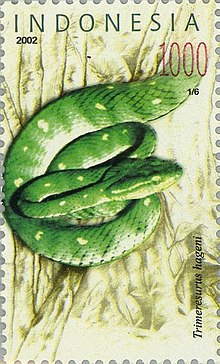| Trimeresurus hageni | |
|---|---|

| |
|
Scientific classification
| |
| Domain: | Eukaryota |
| Kingdom: | Animalia |
| Phylum: | Chordata |
| Class: | Reptilia |
| Order: | Squamata |
| Suborder: | Serpentes |
| Family: | Viperidae |
| Genus: | Trimeresurus |
| Species: | T. hageni
|
| Binomial name | |
| Trimeresurus hageni (
Lidth de Jeude, 1886)
| |
| Synonyms [3] | |
Trimeresurus hageni, commonly known as Hagen's pit viper [4] and Hagen's green pit viper, [1] is a species of venomous snake in the subfamily Crotalinae of the family Viperidae. The species is native to Southeast Asia. There are no subspecies that are recognized as being valid. [5]
Etymology
The specific name, hageni, is in honor of German naturalist Dr. Bernhard Hagen, who collected mammals, birds, reptiles, and insects in the eastern part of Sumatra. [6] [7]
Description

Scalation of T. hageni includes 21 rows of dorsal scales at midbody, 176–198 ventral scales, 63–89 subcaudal scales, and 9–12 supralabial scales. [4] The lectotype has a total length (including tail) of 97 cm (38 in). [3]
Geographic range
T. hageni is found in Peninsular Thailand, Peninsular Malaysia, East Malaysia ( Borneo), and Indonesia ( Sumatra and the nearby islands of Bangka, Simalur, Nias, Batu, and the Mentawai Islands).
The type locality given is "Sumatra ... [and] island of Banka". Brongersma (1933) emended this to "Deli, Sumatra". [2]
Habitat
The preferred natural habitat of T. hageni is forest, at altitudes of 100–300 m (330–980 ft). [1]
Behavior
T. hageni is arboreal and nocturnal. [1]
Diet
T. hageni preys upon amphibians and lizards. [1]
Reproduction
References
- ^ a b c d e Grismer, L.; Chan-Ard, T. (2012). "Trimeresurus hageni ". IUCN Red List of Threatened Species. 2012: e.T191906A2013598. doi: 10.2305/IUCN.UK.2012-1.RLTS.T191906A2013598.en. Retrieved 20 November 2021.
- ^ a b McDiarmid RW, Campbell JA, Touré TA (1999). Snake Species of the World: A Taxonomic and Geographic Reference, Volume 1. Washington, District of Columbia: Herpetologists' League. 511 pp. ISBN 1-893777-00-6 (series). ISBN 1-893777-01-4 (volume).
- ^ a b c Species Trimeresurus hageni at The Reptile Database www.reptile-database.org.
- ^ a b Gumprecht A, Tillack F, Orlov NL, Captain A, Ryabov S (2004). Asian Pit vipers. Berlin: GeitjeBooks. 1st Edition. 368 pp. ISBN 3-937975-00-4.
- ^ "Trimeresurus hageni ". Integrated Taxonomic Information System. Retrieved 28 July 2008.
- ^ Jentink FA (1888). "On a Collection of Mammals from East-Sumatra". Notes from the Leyden Museum 11 (6):17–30.
- ^ Beolens, Bo; Watkins, Michael; Grayson, Michael (2011). The Eponym Dictionary of Reptiles. Baltimore: Johns Hopkins University Press. xiii + 296 pp. ISBN 978-1-4214-0135-5. (Trimeresurus hageni, p. 113).
Further reading
- Brongersma LD (1933). "Herpetological Notes I-IX". Zoologische Mededeelingen (Leiden) 16: 1-29. (Trimeresurus hageni, new combination).
- Das I (2012). A Naturalist's Guide to the Snakes of South-East Asia: Malaysia, Singapore, Thailand, Myanmar, Borneo, Sumatra, Java and Bali. Oxford, England: John Beaufoy Publishing. 176 pp. ISBN 978-1906780708.
- Lidth de Jeude, Th. W. van (1886). "On Cophias Wagleri Boie and Coluber sumatranus Raffles". Notes from the Leyden Museum 8 (10): 43–54. ("Bothrops Hageni", new species, pp. 53–54).
- Sanders KL, Malhotra A, Thorpe RS (2002). "A contribution to the systematics of two commonly confused pitvipers from the Sunda Region: Trimeresurus hageni and T. sumatranus ". Bulletin of the Natural History Museum London (Zoology Series) 68 (2): 107–111.
